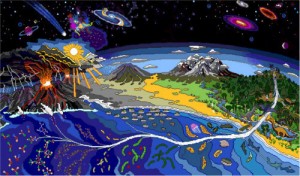The concept of the Big Bang is based on the mindset that the universe is purely a physical1 phenomenon, as was explained in my blog of November 9th, 2014. Whether correct or otherwise, the Big Bang theory sets the agenda for the scientific understanding of life, which is as follows:
- Life emerged from non-life about 3.7 billion years ago
- Life evolved, and continues to evolve, based on mutation, natural selection, and time
- All mutations are by chance.
This essentially means that scientists regard life as a purely physical phenomenon. In reality scientists (geneticists, biologists, etc) had little option but to conclude that life is purely a physical phenomenon – otherwise they would be in conflict with the Big Bang theory.
But what if there is a non-physical2 aspect to the universe and also to life? In my book, Dark Energy and Human Consciousness, I present six logical arguments, based on scientific concepts, suggesting that life requires a non-physical aspect in order to exist.
Argument 1
For any system to exist, it must be influenced by two forces pulling in opposite directions in order to keep ‘tension’ on the system and, thus, keep it in existence. A simple analogy to explain this principle is the example of a clothesline, a system for drying clothes. The clothesline requires two forces pulling in opposite directions to keep it in tension; if one of these forces is removed, then the clothes line will collapse and the clothes will fall to the ground, reaching a state of lower complexity.
In a similar manner, life is a system that exists somewhere between minimum complexity and maximum complexity. Therefore, since matter is the force pulling toward minimum complexity, then there must be another force pulling toward maximum complexity. This force is likely non-physical in nature – therefore it is not yet understood by science.
Argument 2
Life can only evolve to either lower or higher complexity, if the potential for that level of complexity already exists. Imagine if the four forces of nature became united at the present time (as in the Planck epoch), rather than existing as individual forces. In this scenario all matter would return to elementary particles (e.g., quarks, electrons) and finally to the source of elementary particles. However, matter could not possibly go to a level of complexity lower than elementary particles because the potential for that level of complexity does not exist.
In a similar manner, life cannot evolve to higher complexity unless the potential for that higher level of complexity already exists. In other words, a higher level of complexity of life cannot be ‘created’ by a purely physical process.
Argument 3
Humans have the capacity for reason, understanding, care, and compassion. Since none of these attributes are natural characteristics of matter, they must emanate from another source that influences human life.
Argument 4
Argument 4, an intuitive, rather than logical, argument, suggests that, if you look at life and nature in all its beauty, complexity, and diversity, it makes no sense to say that life is purely physical.
Argument 5
At a macro level, scientists accept that dark energy influences the behaviour of the universe because it causes the universe to expand at an accelerating rate. They also accept that dark matter influences the behaviour of galaxy clusters by keeping them gravitationally bound. However, at a micro level, scientists (geneticists, biologists) seem to deny that dark energy or dark matter have any influence on the origin and evolution of life. It is not logical to take the position that 96 per cent of the universe has no influence on life.
Argument 6
Evolution by natural means is unable to prevent the physical aspect of life from evolving to lower complexity, such as occurs with the ageing process, because matter has a natural propensity to return to its source which, I believe, is dark matter. Matter can achieve this goal only by returning along the path by which it emerged, finally reaching the state of quarks and eventually dark matter. In a similar manner, life cannot evolve to higher complexity by natural evolutionary means only: there must be a non-physical source at a maximum level of complexity to which life has a fundamental propensity to return.
Foot Notes
- Physical can be defined as all forms of matter, energy, and momentum, and the physical laws and constants that govern them.
- Non-physical can be defined as everything other than the physical. The non-physical can be viewed as pre-physical or pre-particle – in other words, the state that existed before elementary particles emerged. I believe that both dark matter and dark energy are non-physical which means the physical state only accounts for 4% of reality.
Recent Posts
- Scientific Support for Brexit July 5, 2018
- The Evolution of Human Consciousness November 12, 2015
- Will Science Retreat into a Cul de Sac – just as Theology did before them? September 22, 2015
- Corruption and Abuse of Power are the Source of all the Major Problems in our World September 9, 2015
- A United Europe. Is it a crazy idea? – or – Is it a necessary step in the evolutionary journey of the human race? August 11, 2015
- A New Scientific View of Reality based on The Grand Interactive Model June 9, 2015
- Humanity can create a world dominated by Love, Care, and Compassion April 13, 2015
- The Origin and Evolution of the Universe – The Grand Interactive Model November 28, 2014
- The roles science and theology have played in creating our present world of pain and suffering November 25, 2014
- Science and Theology – A Common Understanding November 18, 2014
Archives
- July 2018 (1)
- November 2015 (1)
- September 2015 (2)
- August 2015 (1)
- June 2015 (1)
- April 2015 (1)
- November 2014 (6)
- October 2014 (6)
- July 2014 (1)




Recent Comments